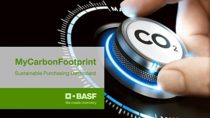Product Carbon Footprint
How much greenhouse gas emissions are associated with a product along its life cycle? This question has become increasingly important over the past years and a Product Carbon Footprint (PCF) can help to find answers.
The PCF sums up the total greenhouse gas emissions generated by a product over the different stages of its life cycle. For example, a cradle-to-gate (partial) PCF considers all the processes from extraction of resources through manufacturing of precursors and the making of the final product itself up to the point where it leaves the company gate. A cradle-to-grave PCF covers the complete life cycle of the product, including the emissions from the use phase and end-of-life of the product.
The following graphic shows the different life cycle stages of a typical BASF product. It explains the PCF contribution of each step and the type of emission it is assigned to (Scope 1, 2, 3).
BASF is highly committed to continuously reduce the PCF of its products. The green graphic demonstrates the reduction levers throughout our value chain.

While BASF is continuously working to achieve net zero CO2 emissions by 2050, more and more customers are making environmentally conscious purchasing decisions. Therefore, BASF has developed a digital application to calculate the cradle-to-gate PCFs for its 45,000 sales products. It enables BASF to provide PCFs for its global portfolio. Customers thus will receive valuable information about the extent to which BASF materials contribute to the carbon footprint of their business activities and their own final products.
BASF's PCF calculation is based on GHG emissions from its own plants and high-quality average data for purchased raw materials as well as purchased energy. BASF will gradually replace average data with supplier specific data for purchased raw materials, as soon as they become available from our suppliers.


Options for reducing PCFs
PCFs provide our customers with valuable information on levers for avoiding greenhouse gas emissions. Already today we offer them added value through the use of alternative raw materials. In this way, we help our customers reduce the carbon footprint of their products.
One example is BASF's biomass balance approach, in which fossil resources are replaced by renewable raw materials, e.g. biomethane or bio-naphtha derived from biomass, in the production Verbund and attributed to the sales product. Another example of the application of the mass balance approach is ChemCycling®. BASF is offering a portfolio of Ccycled® products that are manufactured using secondary feedstock from chemically recycled plastic waste at the start of production. The BASF sales products from both approaches have the same properties as products based on purely fossil raw materials – but with a lower carbon footprint.
- More about Biomass Balance
- More about ChemCycling®
More information about ZeroPCF products and LowPCF products
BASF increasingly offers products with a reduced CO2 footprint (Product Carbon Footprint, PCF) in response to rising demand from customers.
The partial PCF is generally calculated using the digital application certified by TÜV Rheinland, which determines the PCF for almost the entire BASF portfolio and thus nearly 45,000 products. Primary and secondary data are used for the calculation. Secondary data are, for example, raw material data from commercial databases.
The methodology for calculating the PCF is based on the ISO 14040, ISO 14044 and ISO 14067 standards and is compliant with the Greenhouse Gas Protocol Product Standard. The partial Product Carbon Footprint takes into account the greenhouse gas emissions that occur when raw materials are extracted (cradle) until they leave the BASF site (plant gate). The consideration from the cradle to the factory gate (cradle-to-gate) thus only covers part of the product’s life cycle, not a complete life cycle analysis (cradle-to-grave).
If requested by customers, it is possible to reduce the PCF of many products during production, for example by using green electricity or biomass (i.e., via biomass balance). In some cases, the PCFs of BASF products are already lower than the corresponding market benchmark values due to the use of more efficient manufacturing processes (Verbund production with highly efficient energy supply) and advantageous raw materials.
Low-PCF products are products that have a significantly reduced PCF compared to a reference value.
For example, if biomass is used in the production of products, the carbon bound in the biomass reduces the partial PCF. The originally determined PCF can in some cases be reduced to zero or even below zero by including the biogenic carbon of the product. ZeroPCF products are products with a PCF of zero (or less than zero).
The calculation of the partial PCF excludes the use of external compensation measures.
Promotion of international standards and rules
BASF’s PCFs are calculated following general standards for life cycle assessment (ISO 14044) and carbon footprints of products (ISO 14067), as well as the Greenhouse Gas Protocol Product Standard.
These standards do not, however, include concrete specifications as to how exactly the PCF is to be determined for individual products. In the absence of such rules, PCFs of the same products from different companies cannot yet be fully compared. In order to create a level playing field, BASF is committed to the introduction of product-specific guidelines for the calculation of PCFs in the chemical industry to create an industry-wide level playing field and comparability of products.
How to get a more holistic sustainability assessment
PCFs create transparency about greenhouse gas emissions associated with our products. At the same time, they are only one piece of a bigger sustainability picture. Comprehensive sustainability assessments of products include environmental, economic and social criteria. If customers want to get a more holistic picture, we recommend multi-criteria assessment tools like our Eco-Efficiency Analysis.



